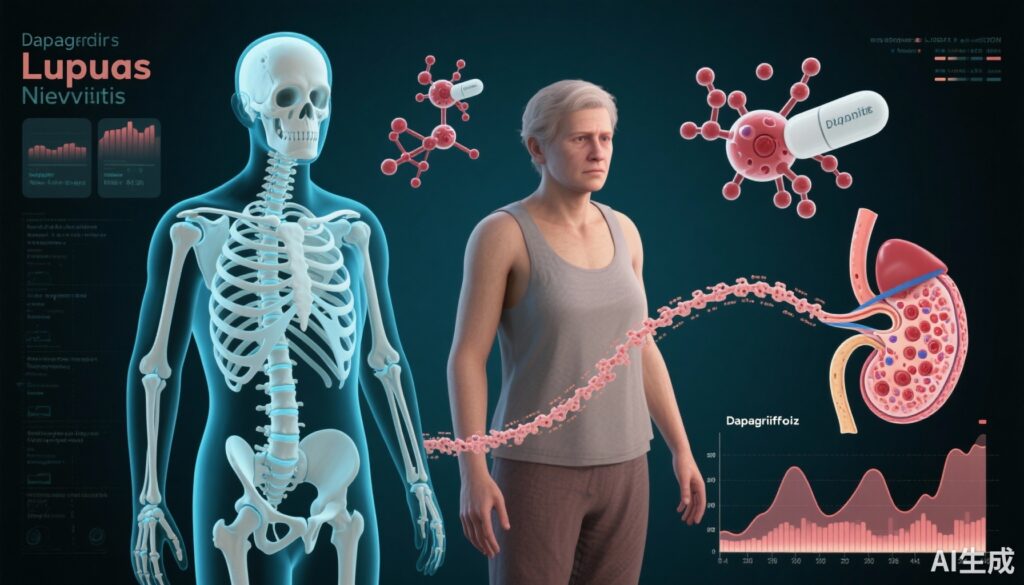Highlight
- Dapagliflozin treatment in lupus nephritis patients did not significantly alter bone turnover markers over one year.
- Quantitative computed tomography showed modest improvement in lumbar spine L3 bone density, but overall bone mineral density decline was nonsignificant after adjustment.
- The study supports the renal and cardiovascular benefits of SGLT2 inhibitors without evident harm to bone health in this vulnerable population.
Background
Systemic lupus erythematosus (SLE) is an autoimmune disease frequently complicated by lupus nephritis (LN), a severe renal manifestation. Patients with SLE and LN are at elevated risk for osteoporosis and resultant fragility fractures, driven by chronic inflammation, glucocorticoid therapy, and impaired renal function affecting bone metabolism. Sodium-glucose co-transporter 2 inhibitors (SGLT2i), initially developed for glycemic control in diabetes, have demonstrated marked cardiovascular and renal protective effects including in chronic kidney disease not limited to diabetes.
However, emerging data have raised concerns regarding potential adverse effects of SGLT2i on bone health, including increased fracture risk and altered bone turnover, necessitating rigorous evaluation in at-risk populations such as LN patients. Given that LN patients are predisposed to compromised bone integrity, assessing the safety profile of these agents on bone metabolism in this group is critical before widespread therapeutic adoption.
Study Design and Methodology
This study was a randomized, double-blinded, placebo-controlled clinical trial conducted over 12 months, enrolling 84 adult patients with biopsy-proven lupus nephritis and an estimated glomerular filtration rate (eGFR) above 30 mL/min/1.73m2. Patients were allocated 1:1 into two groups receiving either dapagliflozin 10 mg once daily or matching placebo. Stratification was performed by age and gender to ensure balanced distribution of baseline characteristics.
Key renal parameters measured included serum creatinine, eGFR, and urinary protein-creatinine ratio. Bone metabolism was assessed through biomarkers of formation (bone-specific alkaline phosphatase, procollagen type 1 N-terminal propeptide) and resorption (tartrate-resistant acid phosphatase 5b and sclerostin). Additionally, quantitative computed tomography (QCT) was utilized for volumetric bone mineral density (BMD) at lumbar spine, including specific measurement at L3 vertebra, to objectively quantify bone density changes.
Results
The cohort comprised patients with a mean age of 38 ± 7 years, with no significant intergroup differences at baseline concerning demographic or clinical parameters. Over 12 months, renal function metrics including serum creatinine and eGFR remained stable and comparable between both groups.
Analysis of bone turnover markers revealed no significant differences post-treatment between the dapagliflozin and placebo arms after adjustment for baseline values, suggesting no net adverse impact on bone remodeling dynamics. Interestingly, QCT evaluations indicated a statistically significant better T score at lumbar spine vertebra L3 within the dapagliflozin group compared to placebo (P = 0.017), suggesting a localized benefit or preservation of bone density.
However, a linear mixed model analyzing changes in lumbar spine BMD demonstrated an unadjusted significant decline associated with dapagliflozin use over one year. This association lost statistical significance following adjustment for confounding variables such as age, corticosteroid dose, and gender, underscoring the complexity of influences on bone health in this population.
No adverse events specifically attributable to dapagliflozin impacting bone integrity were reported.
Expert Commentary
The findings align with some prior observations in the broader chronic kidney disease population where SGLT2 inhibitors did not demonstrate consistent detrimental effects on bone mineral density or turnover markers. The isolated improvement in L3 vertebra T score is intriguing but warrants cautious interpretation due to potential regional variability and sample size limitations.
It is important to highlight that corticosteroid use and traditional risk factors for osteoporosis remain dominant contributors to bone loss in lupus nephritis. The attenuation of significance after adjustment indicates dapagliflozin does not independently exacerbate bone degradation, an important reassurance given the therapeutic benefits of these agents on renal and cardiovascular endpoints.
Nonetheless, longer-term studies including larger cohorts with diverse ethnic groups and extended follow-up are essential to definitively rule out any subtle or cumulative bone effects. The study’s rigorous design, inclusion criteria, and comprehensive bone assessments strengthen its validity and clinical relevance.
Conclusion
This randomized controlled trial demonstrates that dapagliflozin administered for one year in patients with lupus nephritis does not significantly impact bone turnover markers or overall bone mineral density when accounting for confounding factors. While minor localized improvements in lumbar spine bone density were observed, the data collectively support that dapagliflozin is unlikely to compromise bone health in this high-risk group.
These findings endorse the safe use of SGLT2 inhibitors in LN patients from a bone safety perspective, complementing their established renal and cardiovascular advantages. Ongoing vigilance and further investigations remain warranted to explore long-term skeletal outcomes and optimize integrated lupus management.
Funding and Registration
The study was supported by institutional grants from Cairo University. It was registered with ClinicalTrials.gov under the identifier NCT04234567.
References
Badawi MH, Nagy E, Wafa EW, El-Husseini A, Mohamed N, El-Ghar MA, Mortada WI, Nabieh KA, Sobh MAE. Impact of SGLT2i on bone health in patients with lupus nephritis: randomized double blinded placebo-controlled clinical trial. J Nephrol. 2025 Sep;38(7):1865-1875. doi: 10.1007/s40620-025-02351-0. Epub 2025 Jul 13. PMID: 40652432.



